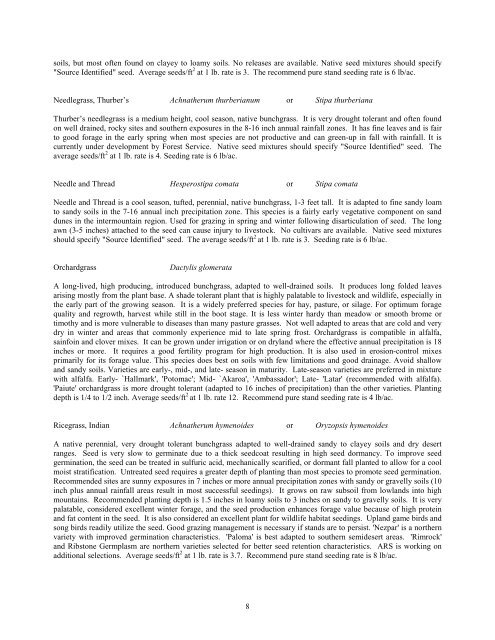Idaho Plant Materials Technical Note No. 24
Idaho Plant Materials Technical Note No. 24
Idaho Plant Materials Technical Note No. 24
Create successful ePaper yourself
Turn your PDF publications into a flip-book with our unique Google optimized e-Paper software.
soils, but most often found on clayey to loamy soils. <strong>No</strong> releases are available. Native seed mixtures should specify<br />
"Source Identified" seed. Average seeds/ft 2 at 1 lb. rate is 3. The recommend pure stand seeding rate is 6 lb/ac.<br />
Needlegrass, Thurber’s Achnatherum thurberianum or Stipa thurberiana<br />
Thurber’s needlegrass is a medium height, cool season, native bunchgrass. It is very drought tolerant and often found<br />
on well drained, rocky sites and southern exposures in the 8-16 inch annual rainfall zones. It has fine leaves and is fair<br />
to good forage in the early spring when most species are not productive and can green-up in fall with rainfall. It is<br />
currently under development by Forest Service. Native seed mixtures should specify "Source Identified" seed. The<br />
average seeds/ft 2 at 1 lb. rate is 4. Seeding rate is 6 lb/ac.<br />
Needle and Thread Hesperostipa comata or Stipa comata<br />
Needle and Thread is a cool season, tufted, perennial, native bunchgrass, 1-3 feet tall. It is adapted to fine sandy loam<br />
to sandy soils in the 7-16 annual inch precipitation zone. This species is a fairly early vegetative component on sand<br />
dunes in the intermountain region. Used for grazing in spring and winter following disarticulation of seed. The long<br />
awn (3-5 inches) attached to the seed can cause injury to livestock. <strong>No</strong> cultivars are available. Native seed mixtures<br />
should specify "Source Identified" seed. The average seeds/ft 2 at 1 lb. rate is 3. Seeding rate is 6 lb/ac.<br />
Orchardgrass<br />
Dactylis glomerata<br />
A long-lived, high producing, introduced bunchgrass, adapted to well-drained soils. It produces long folded leaves<br />
arising mostly from the plant base. A shade tolerant plant that is highly palatable to livestock and wildlife, especially in<br />
the early part of the growing season. It is a widely preferred species for hay, pasture, or silage. For optimum forage<br />
quality and regrowth, harvest while still in the boot stage. It is less winter hardy than meadow or smooth brome or<br />
timothy and is more vulnerable to diseases than many pasture grasses. <strong>No</strong>t well adapted to areas that are cold and very<br />
dry in winter and areas that commonly experience mid to late spring frost. Orchardgrass is compatible in alfalfa,<br />
sainfoin and clover mixes. It can be grown under irrigation or on dryland where the effective annual precipitation is 18<br />
inches or more. It requires a good fertility program for high production. It is also used in erosion-control mixes<br />
primarily for its forage value. This species does best on soils with few limitations and good drainage. Avoid shallow<br />
and sandy soils. Varieties are early-, mid-, and late- season in maturity. Late-season varieties are preferred in mixture<br />
with alfalfa. Early- `Hallmark', 'Potomac'; Mid- `Akaroa', 'Ambassador'; Late- 'Latar' (recommended with alfalfa).<br />
'Paiute' orchardgrass is more drought tolerant (adapted to 16 inches of precipitation) than the other varieties. <strong>Plant</strong>ing<br />
depth is 1/4 to 1/2 inch. Average seeds/ft 2 at 1 lb. rate 12. Recommend pure stand seeding rate is 4 lb/ac.<br />
Ricegrass, Indian Achnatherum hymenoides or Oryzopsis hymenoides<br />
A native perennial, very drought tolerant bunchgrass adapted to well-drained sandy to clayey soils and dry desert<br />
ranges. Seed is very slow to germinate due to a thick seedcoat resulting in high seed dormancy. To improve seed<br />
germination, the seed can be treated in sulfuric acid, mechanically scarified, or dormant fall planted to allow for a cool<br />
moist stratification. Untreated seed requires a greater depth of planting than most species to promote seed germination.<br />
Recommended sites are sunny exposures in 7 inches or more annual precipitation zones with sandy or gravelly soils (10<br />
inch plus annual rainfall areas result in most successful seedings). It grows on raw subsoil from lowlands into high<br />
mountains. Recommended planting depth is 1.5 inches in loamy soils to 3 inches on sandy to gravelly soils. It is very<br />
palatable, considered excellent winter forage, and the seed production enhances forage value because of high protein<br />
and fat content in the seed. It is also considered an excellent plant for wildlife habitat seedings. Upland game birds and<br />
song birds readily utilize the seed. Good grazing management is necessary if stands are to persist. 'Nezpar' is a northern<br />
variety with improved germination characteristics. 'Paloma' is best adapted to southern semidesert areas. 'Rimrock'<br />
and Ribstone Germplasm are northern varieties selected for better seed retention characteristics. ARS is working on<br />
additional selections. Average seeds/ft 2 at 1 lb. rate is 3.7. Recommend pure stand seeding rate is 8 lb/ac.<br />
8
















